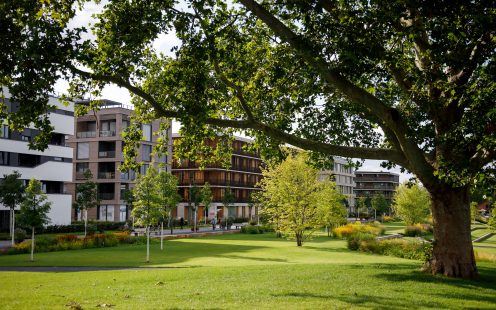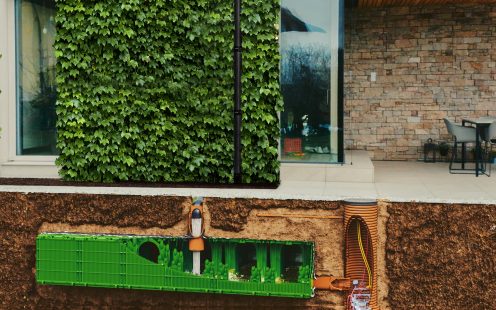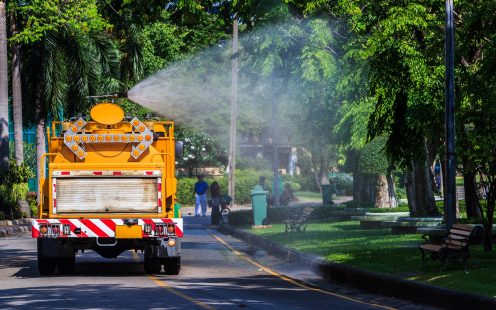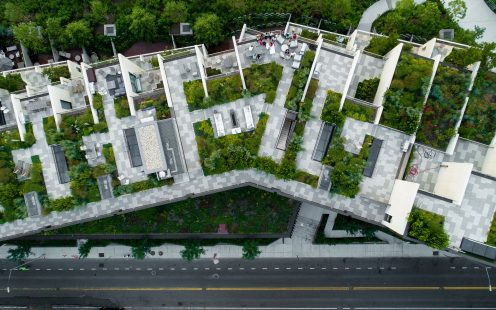From Heat Islands to Green Islands: Transforming Modern Cities in the Face of Climate Change
Due to increasing extreme temperature events and growing urbanization, Europe’s cities have become vulnerable to environmental hazards, such as excess heat and increased pollution, causing concerns for the health and well-being of local populations. While heatwaves and urbanization are both expected to increase in the future, changing the city infrastructure can mitigate their adverse effects. Urban greening, in particular, is seen as a major strategy to keep modern cities cool and comfortable. We invited Pipelife’s Irrigation Specialist Konstantinos Akritanakis to share his expertise in greenspace solutions and adapting them to the city conditions in a sustainable way.

Europe’s Cities Are Warming Up
Currently, more than 70% of all Europeans live in cities, and urbanization keeps increasing due to economic and social causes. However, as Europe’s metropolises are growing, so do the temperatures inside them. Covering vast land areas with pavement and buildings has increased heat absorption and retention. Such an infrastructure, together with the extra heat generated by human activities, has caused many cities to become significantly warmer than the rural areas surrounding them.
The phenomenon is known as the urban heat island effect, and the difference between a busy metropolitan area and its surroundings can reach 3-5 °C or more. With global temperatures expected to rise further, heating cities have become an issue requiring an urgent solution.
A Green Array Keeps the Heat Away
Urban greening is one of the key strategies for increasing heat resilience in cities. Apart from creating shade over areas that typically draw and retain heat, plants also evaporate water and produce oxygen, keeping the air fresh. Furthermore, green spaces have been shown to improve the emotional well-being of city dwellers.
While new districts nowadays are typically planned envisioning sufficient green zones, bringing vegetation back to the areas that have been covered in concrete and mortar for decades can be difficult.
“When we talk about the engineering of urban greeneries, the most important challenge is space. In most cities, space is limited, and it is not easy to create large green areas. The second challenge is maintenance — how to care for such areas long term and how to make them sustainable regarding water and energy consumption,” comments Konstantinos Akritanakis, R&D Project Manager for irrigation solutions at Pipelife.

Green Facades: Giving City Premises a New Face
Also known as vertical gardens or eco-walls, green walls have been enjoying growing popularity in urban greenspaces. Among other benefits, plant-covered facades efficiently reduce surface temperatures, improve air quality and help increase biodiversity in the area. Besides, unlike other urban greening solutions, green facades require minimal ground space.
However, from structural damage caused by plant roots to high irrigation costs and complex maintenance, improperly planned green walls can also pose problems to buildings and their owners. Plants used on green walls require regular water supply and fertigation, which, depending on the setup of the wall, may require professional care.
“There are two main ways of creating green walls. One is planting climbing plants at the ground level, and the other is hanging pots or installing panels on the wall,” explains Akritanakis, “Walls with climbing plants are the easiest to care for. For example, it is possible to collect rainwater from the roof in underground retention crates and pump it to the irrigation pipe in the root area — such a system is largely self-sufficient and requires hardly any maintenance.”

Improving Irrigation for Urban Greenspaces
Where the space allows, city parks, gardens and street trees are still the most common forms of urban greening. However, these areas are affected by rising temperatures as well — higher water consumption and more complicated maintenance are two challenges that have arisen. Many municipalities have had to increase irrigation to preserve the parks and gardens during extended periods of heat and drought.
“In many cities, you can see trucks with water tanks driving around at night irrigating gardens and trees — our goal is to develop green zones that are independent and self-sustainable,” states Akritanakis, “As an example, we offer pressure-compensated drip irrigation pipes that can be installed underground. No matter the elevation and the slope, the optimal amount of water is automatically delivered to each plant. In addition, we can collect the rainwater from roads or gutters in underground tanks or retention crates and use it to irrigate plants during dry periods.

Green Roofing: Changes From a Bird’s Eye View
Green roofs are another way to reintroduce biodiversity to cities while protecting urban structures and people from excessive heat. Properly planned green roofs not only cool buildings in summer but also provide heat insulation in winter while enhancing building aesthetics and improving air quality.
Extensive green roofs require less than 20 cm of substrate; they house smaller plants and can be either sloped or flat. Intensive green roofs or the so-called roof gardens feature a deeper soil layer and support more varied vegetation, sometimes even bushes or trees.
Setting up a green roof of any kind requires a professional assessment of how much added weight the building can support, as well as a design that would ensure adequate irrigation, prevent root damage and excessive moisture build-up.
“With green roofs, there is a risk of overirrigation,” clarifies Akritanakis, “A small leakage can form, and, if there is an issue with water insulation, the water will seep into the office, the apartment, or whatever it is below.”
However, modern green roof systems are considered extremely safe and contain a waterproofing layer, a root barrier as well as precision irrigation and drainage systems.
“Micro drip irrigation allows providing the exact amount of water needed, so the risk of overirrigation is low. For larger buildings, where it is possible to put 30 to 40 centimeters of substrate on the roof, drainage systems are also installed that take any excess water away and direct it to the stormwater system or collect it for later reuse,” says Akritanakis.
Better City Environments With Less Effort
According to the European Environment Agency, the last decade in Europe has been the warmest on record, with land temperatures increasing by more than 1.9 °C compared to pre-industrial levels. Especially in cities, the heat periods have been becoming more intense and frequent, making municipalities seek solutions on how to cool down the heat islands their communities reside in.
“As the temperatures will keep rising in the future, more and more attention will be brought to urban greening solutions. However, the emphasis will be not only to make sure these areas look nice but also to ensure they are easy to maintain. We can see a trend to move away from complicated urban greening solutions toward self-sustainable solutions,” sums up Akritanakis, “And we, engineers, are asked not only to find urban greening solutions per se but also to find solutions that would take the sustainability challenges into account.”
Discover Our Solutions for Urban Landscapes
Get in Touch
Please choose your preferred way to get in contact with us. We will get back to you as soon as possible.
Fill our form